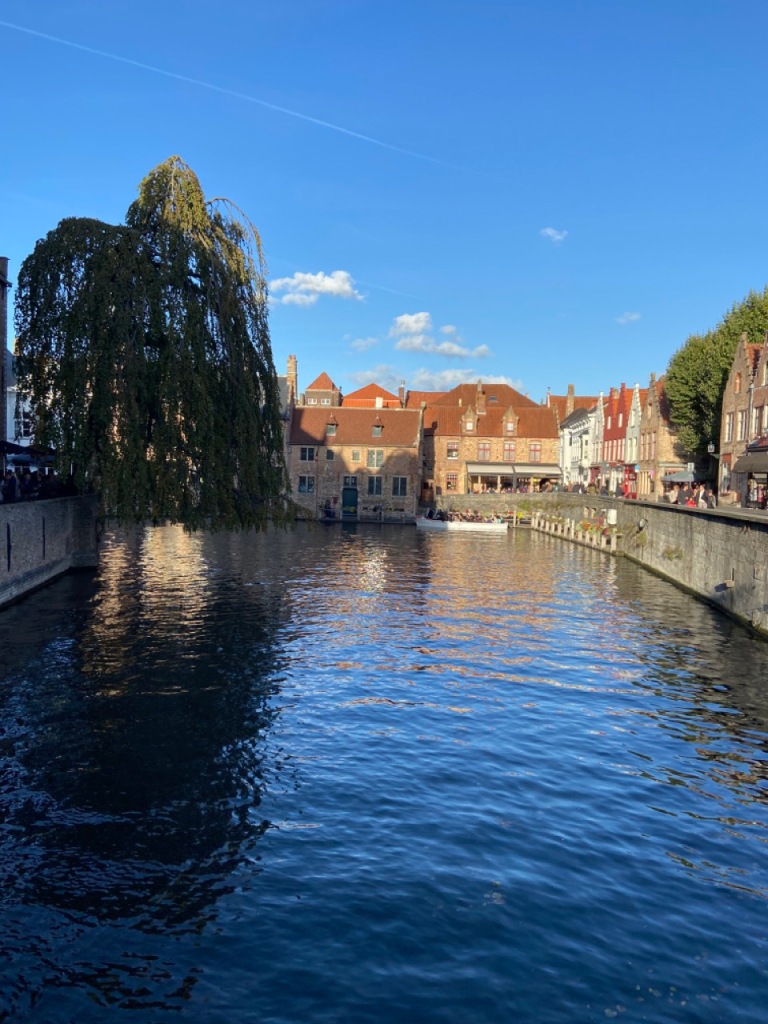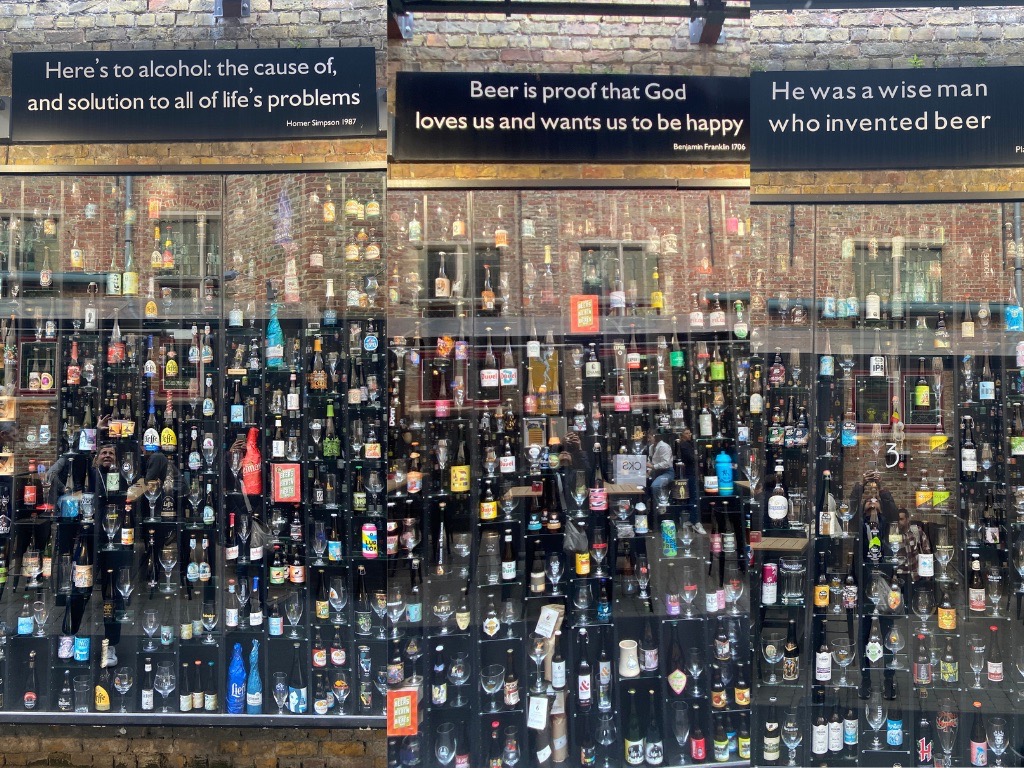Bruges was an important trading post for about 400 years, from the 12th to the 15th century. It is close to the sea but does not have a natural river emptying into the sea. One storm elevated Bruges to a major port, and another set the tone for its downfall years later. Today Bruges is known for its lace, buildings with gabled roofs, the belfry, and of course, the canals. The Bruges we see today has transformed many times over from the day it was a small fort on an islet with rivulets and streams flowing around it that did not go far enough on the flat plains to join the North Sea.
If you look at the map, you will see canals in the old city that suddenly seem to disappear. Ever wondered why? While the first storm transformed the rivulets into a fair waterway, allowing boats to ply goods, making it a prosperous town, the second storm silted up the river, and over time, it became unnavigable. The fort of Bruges underwent modifications as the canals receded, and today in some places, the canals seem to disappear overground but are actually flowing underground. Brugge, as Bruges is known in Belgium, is Flemish for ‘bridge’. It’s like a nickname that sticks. The fort on the islet had a bridge connecting it over the rivulet. Small businesses were set up just outside the fort to serve it. When folks did not find accommodation in the fort, they would go to the ‘bridge’ and find a room in one of the inns. The new town that grew around the inns became known as Brugge.
We reached Bruges late afternoon on a Friday. We checked into this cozy B&B on Predikherenrei, just off the canal, with boats moored along the side in a quieter part of Bruges, a short walk from the city centre. We reached long after lunchtime, making it difficult to find a place to eat as most restaurants along the way had closed for the afternoon break. We were paid well for our patience as we ended up in a restaurant opposite the most Instagrammed spot in Bruges, Rozenhoedkaai. As we ate hungrily and in silence, we watched tourists pause to admire the view, vying for a place to take a pic and posing for takes and retakes. There is a boat tour jetty right there. Post the tour, the horde of passengers take pics. It gave us a good idea of when to take our pics (as soon as the boats leave on the canal tour).
Rozenhoedkaai (the Rosary Quai) was where rosaries were sold once upon a time. Here, the rivulet goes underground and reappears a little later to join another stream, and together, they flow northwards.
After lunch, we strolled towards the compact Grote Markt. The belfry in the Cloth Hall is the most remarkable thing here. Its foundations go deep under the canal that itself runs underground here. In the past, sentries kept an eye out for fires and enemies from the upper levels of the belfry. They would sound the alarm in case of an emergency. The belfry chimes every quarter hour and has been telling time for a long time.
Cloth Halls were a status symbol, and this is one of the larger ones in Europe that used to be a bustling place. Lace, fine cloth, and other goods would be traded here.
When you stand with your back towards the belfry, on the opposite side, you see statues of two men who played an important role in the Flemish uprising against their french king. But what caught my eye were the facades of colourful gabled buildings with cafes and restaurants. On one end of these 17-century buildings is the Cranenburg House which, while it no longer looks like the original, used to be the most magnificent private residence in the Markt, the house of the Counts of Flanders. This is also where Maximillian I, the king of Romans, was held prisoner. Another worthy building in the Markt is again one of the oldest and the only one without a gabled roof; Huis Bouchoute has a golden ball on its top and a compass on its façade. The Markt is also home to the Provinciaal Hof, the seat of the office of the West Flanders, which no longer plays any role except to host exhibitions.
Our next stop was De Brug, home to the City Hall, a cheerful white Gothic building with a pop of red. It is one of the oldest City Halls in the Netherlands region. On one side is the Basilica of the Holy Blood. As it was closing time, we made a mental note to visit the basilica the next day. We walked along and discovered the house where King Charles II stayed while he was a monarch-in-waiting. It is today the Grand Hotel Casselbergh.
We continued, crossing over the canal at Molenbrug, where the dyers’ dock (Verversdijk) used to be. Molenbrug gets its name from a mill that was located here. It is one of the prettier bridges in Bruges with several restaurants along the canal. We rewound our way to the B&B with our tummies still full from the late lunch and called it a day.
On Saturday, we ventured out leisurely and took a different route towards the City Hall – through a park and crossed the canal a few times, analyzing which of the bridges was more picturesque than the other. We made our way to the Basilica of the Holy Blood.
The two-level basilica is very different from the other catholic places of worship I have seen so far. The façade is a dark grey with gold. The lower basilica is simple, without embellishments, and is dedicated to Saint Basil the Great.
A low, curving staircase with brightly painted glass windows leads to the upper level.
Dainty vines cover the slatted wooden arched ceiling of the upper basilica. The wall behind the altar is covered with elaborate artwork. Curved arches with delicate floral and geometric patterns separate the main church from the chapel on the side. The pulpit looks like a dark ball; it apparently represents the globe. The canopy of the pulpit is a bright cloth umbrella rather than wood.
The upper basilica houses the relic of the Holy Blood (taking pics is not allowed). According to believers, Joseph of Aramathea, who washed the body of Christ before placing him in the tomb, did not discard the bloodied cloth; instead, it became a part of the Relics of Passion. Thierry of Alsace, the Count of Flanders from 1128 to 1168, brought the relic from Jerusalem to Bruges. Today you can view it in this basilica. Every year, the relic is taken out in a grand procession, which has been a tradition for about 750+ years. The relic is housed in a glass cylinder sealed on both sides with gold caps, and the glass cylinder is clasped on either ends to a silver chain.
On a whim, we visited the Beer Museum, and we enjoyed the experience and highly recommend that it be on your list when you visit Bruges. We walked on further and saw the Beer Wall Street, which, while it has some nice quotes and a view at the end, which is just ok actually, there’s not much to do.
While the better half was trying to catch up on some work calls, I took a deviation and visited the small Groningen Museum, which houses paintings of the two great Flemish Masters, Jan van Eyck and Hans Memling, among others. Museums can be overwhelming, and one cannot see everything in one visit, or even a section can take up many hours. That way, small museums are good because you can see, appreciate, understand and be more art-oriented after the visit. Bruges has its share of museums, so take your pick. After my museum visit, the better half rejoined, and we strolled along toward the much-photographed Bonifacius Bridge.
Looming over it are the spires of the Church of our Lady of Bruges, which holds a very famous Mary and Infant Jesus statue sculpted by none other than Michaelangelo. The plaza outside the church has several other medieval buildings that look straight out of a movie set.
Exit from there on towards the Dvijer, and before you get distracted by the passengers on the canal tour boats, take a moment to admire the map of Bruges stretched out on a metal frame; made of lace! Bruges has a lace centre which I could not visit but I think would have been a wonderful few hours learning the history of lace in relation to Bruges and of course the process of lacemaking.
We returned to the Grand Markt to meet the better half’s cousin and his wife, who had come all the way from Germany to spend a few hours with us. What better way to acknowledge this gesture than by catching up over a few beers!
Our son had recommended a microbrewery called De Garre that sells beer with an ABV of 11%. It is opposite the Beer Museum on Breidelstraat, and the entrance is through a narrow alley between two buildings making it easy to miss. In the olden days, these were fireman alleys. Unfortunately for us, the place was shut.
So we went to the De Halve Maan, another must-do brewery, I would say, simply because it is one of three breweries of Bruges with a lot of history attached to it. The sixth generation manages the brewery today. One of the beers, Brugse Zot, translates to ‘Bruges Fool’ and even has a clown on the label. Read to know why 🙂
We checked out Sunday morning and found it quite challenging to get a cab to the station. The owner of the B&B turned up like a godsend and drove us to the station. We could not thank him enough.
That’s about all we could see and do in our 36 hours in Bruges. The bedside table in our B&B had a book called ‘The 500 hidden secrets of Bruges’ by Derek Blyth. We managed just about 5 things and need to return someday to do the other 495 mentioned therein. Fingers crossed 🙂 We spent about the same amount of time in Brussels and you can read all about it here.














